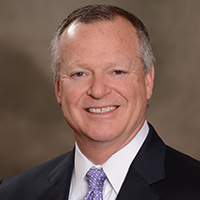Why healthcare organizations should adopt a transformational mindset coming out of COVID-19
- The COVID-19 pandemic presents daunting challenges for healthcare organizations but also an opportunity to implement new ways of doing business.
- In the short term, the task for organizations is to get past the disillusionment phase of disaster recovery and into the reconstruction phase.
- After that, organizations should look to evolve to become less provider-centric and more consumer-centric, said Joseph J. Fifer, president and CEO of HFMA, during the opening presentation of HFMA’s Digital Annual Conference.
As the healthcare industry starts to consider a post-COVID-19 era, leaders should think about how they can go beyond reconstruction to transform their organizations.
That was the core message in remarks by HFMA President and CEO Joseph J. Fifer, FHFMA, CPA, on Wednesday during HFMA’s Digital Annual Conference. His session, “COVID-19: Beyond Reconstruction to Transformation,” kicked off the first day of the six-day event.
“This moment represents a unique opportunity for transformation, using this catastrophe as an accelerant to move things along,” Fifer said.

Joseph J. Fifer
Moving down the road to recovery
Fifer referenced a model used by the Substance Abuse and Mental Health Services Administration to describe the six stages of a society’s response to a disaster:
- Pre-disaster
- Impact
- Heroic
- Honeymoon
- Disillusionment
- Reconstruction
The U.S. has moved out of the honeymoon phase, characterized by a sense of optimism that things soon will return to normal, and into the disillusionment phase, Fifer said. In that phase, “Communities and individuals realize the limits of their disaster assistance. As optimism turns to discouragement and stress takes its toll, negative reactions may begin to surface in all kinds of different ways. Productivity drops. The energy to find innovative solutions is diminished.”
The disillusionment phase can last months or even years. But eventually, the reconstruction phase takes hold as individuals and communities begin to assume responsibility for rebuilding their lives and a sense of recovery becomes pervasive.
“The challenge for our country, and particularly for us in the healthcare industry, is to move out of the disillusionment phase and into reconstruction,” Fifer said. “It’s not a simple process, and it’s not linear.”
The industry must overcome numerous roadblocks as it looks ahead to reconstruction:
- Financial losses
- Payer mix changes due to local unemployment
- Volume losses
- Patient concerns about the safety of healthcare settings
- Impact of COVID-19 on an organization’s workforce
- Uncertain COVID-19 trajectories
Transforming organizational approaches to serve consumers
As formidable as the task may be, surmounting those challenges and fulfilling the reconstruction phase should not be the ultimate target, Fifer said. Instead, leaders should seek to engineer organizational transformation.
“It’s understandable that after a crisis of this magnitude, we just want to go back to the way things were,” Fifer said. “But we know that the old status quo was unsustainable.”
The crux of the transformation that’s needed is moving from a provider-centric operation to a consumer-centric model, Fifer said.
The patient financial experience should be an area of emphasis. As claims for COVID-19 care continue to be adjudicated and bills come due, “There are going to be more cases where patients believe they’re being billed for amounts that they shouldn’t have to pay,” Fifer said. Expectations will be raised for transparency and changes to insurance benefit design.
More generally, “This environment has put us in a situation where we’ve had to design new practices and policies,” Fifer said. “Some of them are consumer-centric.”
For example, to avoid having patients sit in a waiting room and potentially be exposed to the virus, some organizations have implemented a system that allows patients to check in via their phone while in the parking lot and then be alerted to come in when their room is ready. The process can make for a better registration experience.
Such nimbleness and ingenuity are vital for legacy providers to thrive amid competition from a horde of newer entrants to healthcare, ranging from marquee names like Amazon to startups with niche ideas for improving the consumer experience, Fifer said.
Getting change initiatives underway
Organizations looking to transform themselves into a more consumer-centric operation should begin by considering the four C’s of change management, Fifer said:
- Comfort
- Control
- Confidence
- Competence
“If they are in place, that allows for change management processes to move that much more efficiently and quickly,” Fifer said.
Virtual care models will be a staple of transformed organizations, with the pandemic having shown consumers’ willingness and even eagerness to use such platforms. Providers took a few weeks to build telehealth infrastructure that they had been mulling for years.
“What’s the happy medium where we don’t lose that sense of urgency when this is over?” Fifer said.
An industry going above and beyond
HFMA’s theme for the 2020-21 fiscal year is “Your Challenge. Our Mission,” reflecting the stakes for healthcare. The Association always has strived to support its members through the challenges they face in their careers and their organizations, Fifer said. And the pandemic has presented challenges of unprecedented scale and scope.
Via resources such as online news and education and the peer-to-peer HFMA Community network, HFMA will support its members every step of the way.
Fifer said he’s inspired and awestruck by the lengths to which providers go to serve patients, especially during a crisis such as COVID-19.
“Healthcare leaders and professionals have stepped up to meet the challenges of this pandemic in ways that would have been hard to imagine just a few months ago,” Fifer said. HFMA’s FY21 theme is “meant to tell you that we’re right there with you.”





